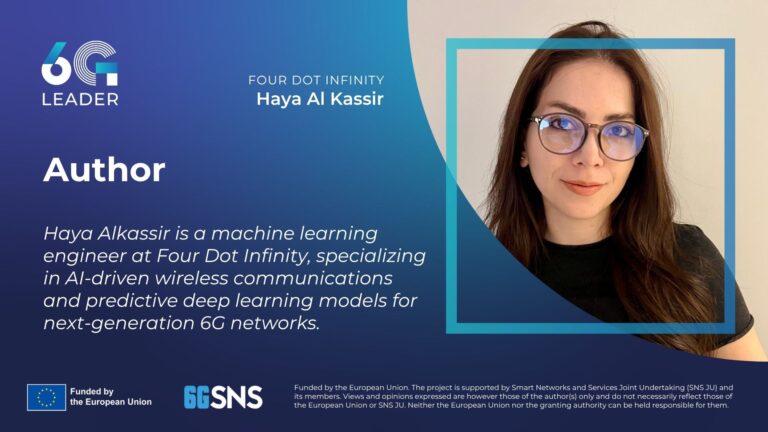The wireless landscape is on the brink of its most transformative shift yet. As we enter the 6G era, networks will be called upon to enable diverse novel use cases, including real-time holographic communication, public protection and disaster relief (PPDR), autonomous vehicle coordination, and AI-driven industrial automation. These use cases demand not just high data rates and ultra-low latency, but also networks that are inherently adaptable, resilient, and capable of making decisions on the fly.
Yet the majority of today’s networks remain fundamentally reactive. They respond to congestion only after it causes delays, adjust routing after packet loss, and modify power allocation only when inefficiencies have already occurred. This reactive paradigm will introduce scalability challenges to meet the demands of dense, high-speed, and intelligent 6G systems. Overall, remaining reactive comes with steep technical, economic, and environmental costs. Technically, these networks struggle to meet the sub-10-millisecond requirements essential for mission-critical services. Economically, inefficient handovers and uncoordinated resource allocation waste valuable spectrum and processing power. Environmentally, constant reconfigurations and unnecessary retransmissions increase energy consumption and carbon emissions. As a result, we need to rethink network design, shifting towards radio access networks (RAN) that are predictive and proactive by design.
This challenge signals a broader shift in our relationship with technology. From the edge to the core, networks need to become anticipatory, learning from the past, adapting to current conditions, and planning for the future. This is not merely about implementing smarter algorithms. It also requires embedding intelligence into the architecture of our networks.
In 6G-LEADER, we believe predictive intelligence must be at the heart of 6G, not treated as an optional enhancement. To this end, we are training and deploying AI/ML models that do not simply optimize retrospectively but anticipate network conditions and proactively adapt. Our approach brings together reinforcement learning, Bayesian optimization, and online feedback mechanisms to enable real-time channel prediction, power control, and resource allocation. We deploy these models in containerized xApps and dApps, allowing them to run at the network edge for fast inference and continuous retraining based on live performance data.
Take channel estimation as an example. Instead of using traditional pilot-based methods that react to fast fading after it occurs, our models learn channel dynamics, predict impairments, and adjust transmission strategies within milliseconds. This capability is vital in high-mobility environments or scenarios with severe interference.
Moreover, we pair predictive modeling with semantics-aware transmission strategies, enabling the network to prioritize which packets are transmitted based on context and importance, reducing control plane overhead and improving energy efficiency across the system.
Prediction in Practice: From Vision to Deployment
Within 6G-LEADER, we are contributing to:
- AI-driven physical layer algorithms for channel estimation under uncertainty.
- Real-time resource allocation xApps powered by deep reinforcement learning.
- Semantics-enhanced xApps/dApps for context-aware data prioritization.
- AirComp-enabled wireless frameworks for collaborative training and model aggregation at the edge.
Together, these innovations aim to transform the RAN into an intelligent, goal-driven system capable of anticipating congestion, adapting to topological changes, and optimizing energy usage in real-time.
Our vision is primarily aimed at practical deployment. All models are designed for real-time operation within open, disaggregated O-RAN architectures, leveraging existing standard interfaces and containerized orchestration for seamless integration. In this manner, we will ensure predictive intelligence that can be deployed across a wide variety of RAN configurations and use cases.
The shift to predictive operation is not just ideal but necessary. As networks become more dynamic, diverse, and decentralized, the latency introduced by reactive systems becomes a critical bottleneck. Another illustrative example involved autonomous drones. In such cases, if a network waits for interference before acting, the drone may already be out of range. If mobility is managed only reactively, augmented reality sessions may freeze before a handover completes. These challenges are not theoretical, they represent real barriers to deploying advanced services.
6G networks must be adaptive by design. AI/ML must function not as offline optimization tools or monitoring aids but as integrated, predictive agents capable of forecasting network states and executing informed actions at sub-second timescales. In this sense, predictive networks are not just about enhancing performance, they are about building trust. Networks that anticipate user needs, optimize their operations, and avoid failures inspire confidence among developers, operators, and end-users.
We envision 6G as a collaborative ecosystem where real-time learning and adaptation occur across devices, nodes, and applications. This ecosystem will be powered by lightweight, intelligent agents, like the xApps and dApps we are developing, that specialize in forecasting, decision-making, and the provision of spectral-efficient and sustainable 6G networks.
As we look ahead to 2030 and beyond, the question is not whether 6G networks should predict the future, but whether they can afford not to. For us, the answer is clear: predictive intelligence is essential, and the work to embed it into our networks begins now.







